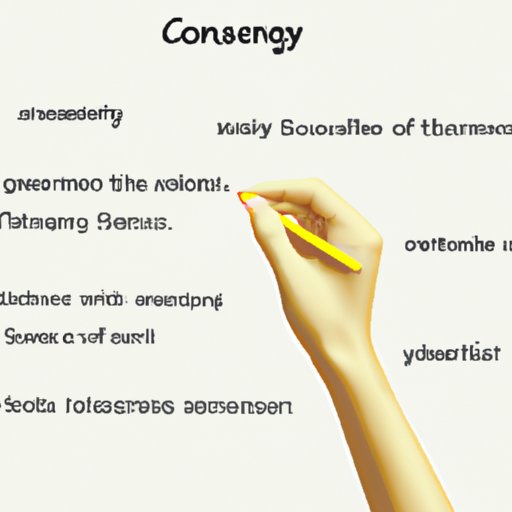Introduction
Descriptive writing is a form of writing that describes something, someone, or an experience. It captures an event or a moment in time through the use of imagery, sensory details, and figurative language. It paints a vivid picture for the readers and helps them to understand the subject better.
Descriptive writing is important in both fiction and non-fiction works. It can help authors create a compelling story or bring a dull topic to life. With descriptive writing, authors can evoke emotions, engage the reader, and create a lasting impression.
Exploring the Elements of Descriptive Writing
To write descriptively, authors must effectively use imagery, sensory details, and figurative language. Imagery is descriptive language used to evoke an image in the reader’s mind. Sensory details are descriptions of how something looks, smells, tastes, sounds, and feels. Figurative language includes metaphors and similes that compare two unlike things in order to create a vivid image.
A Guide to Crafting Descriptive Writing
Brainstorming is an effective way to begin writing descriptively. Authors should take some time to think about the subject and jot down their ideas. Once the author has gathered their thoughts, they can begin to craft their descriptive writing.
The use of metaphors and similes can also be very helpful. These figures of speech compare two unlike things in order to create a vivid image in the reader’s mind. For example, an author may describe a sunset as “a blanket of fire in the sky.”
When crafting descriptive writing, authors should also select specific words. Instead of using generic words, authors should use words that are more precise and evocative. For example, instead of saying “the sky was blue,” an author could say “the sky was azure.”

Understanding the Power of Descriptive Writing
Descriptive writing has the power to create a mental image in the reader’s mind. By using vivid language and imagery, authors can create a vivid picture for the readers and help them to understand the subject better.
Descriptive writing can also engage the reader. By painting a vivid picture, authors can draw readers into the story and keep them interested. This is especially true in fiction writing, where authors need to create a compelling world and characters for the readers.
Finally, descriptive writing can evoke emotion. By using sensory details, authors can evoke feelings in the readers and create a stronger connection between them and the subject matter.
Tips for Writing Descriptively
One of the most important tips for writing descriptively is to show, don’t tell. Instead of simply telling the readers what is happening, authors should use descriptive language to paint a vivid picture. This will help the readers to connect with the story on a deeper level.
Authors should also use all five senses when writing descriptively. By describing how something looks, smells, tastes, sounds, and feels, authors can create a more vivid image in the reader’s mind.
When writing descriptively, authors should also focus on specifics. Instead of using generic words, authors should be as specific as possible in order to create a more vivid image. For example, instead of saying “the tree was tall,” an author could say “the oak tree was towering above me.”
Authors should also vary their sentence structure when writing descriptively. By varying the length and structure of sentences, authors can create a more engaging and interesting piece of writing.
Finally, authors should avoid clichés when writing descriptively. Clichés are overused phrases that have lost their impact. Instead of using clichés, authors should strive to use fresh and original language.

How to Make Your Writing Come Alive with Descriptive Writing
One way to make your writing come alive with descriptive writing is to use personification. Personification is a figure of speech in which human qualities are attributed to an object or animal. This can help authors create a vivid image for the readers and make the writing more engaging.
Authors can also create contrast when writing descriptively. By contrasting two different elements, authors can create a more vivid image for the readers. For example, an author may describe a beach at sunrise as “the quiet calm of the night juxtaposed against the vibrant colors of the morning sky.”
Finally, authors should describe actions when writing descriptively. By describing the movements and gestures of characters, authors can create a more vivid image in the reader’s mind.
Examples of Descriptive Writing
Here are some examples of descriptive writing:
“The sun rose in the sky like a fiery orb, casting its warm glow across the land. The air smelled of freshly cut grass and the birds were singing in the trees. I could feel the cool breeze on my skin, and I closed my eyes and breathed in the sweet scent of summer.”
“The old man shuffled slowly down the street, his hands shaking and his head bowed low. He wore a worn coat that was several sizes too big, and his shoes were scuffed and tattered. His face was creased with wrinkles, and his eyes were filled with sadness.”

The Benefits of Descriptive Writing
Descriptive writing has many benefits. It enhances the reader’s experience by creating a vivid image in their mind. It also improves the quality of writing by making it more engaging and interesting. Finally, it creates a lasting impression on the reader, allowing them to remember the story or topic for a long time.
Conclusion
Descriptive writing is a powerful tool that authors can use to engage the reader, evoke emotion, and create a vivid image in the reader’s mind. With the use of imagery, sensory details, and figurative language, authors can craft a compelling piece of writing that will leave a lasting impression on the reader.
(Note: Is this article not meeting your expectations? Do you have knowledge or insights to share? Unlock new opportunities and expand your reach by joining our authors team. Click Registration to join us and share your expertise with our readers.)
